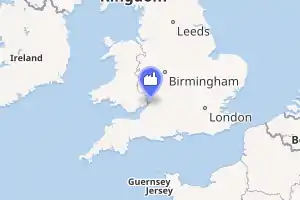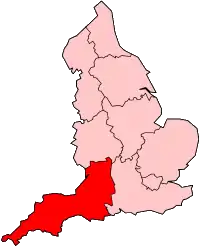Lydney power station
The Lydney power station supplied electricity to 300 square miles (780 km2) of West Gloucestershire, England from 1923 until 1967. The supply area included the Forest of Dean, Stroud and Nailsworth. The station was owned by the West Gloucestershire Power Company Limited prior to the nationalisation of the British electricity supply industry in 1948. The station was closed in 1967.
| Lydney power station | |
|---|---|

| |
| Country | England |
| Location | Lydney Gloucestershire |
| Coordinates | 51°44′06″N 02°32′18″W |
| Status | Decommissioned and demolished |
| Construction began | 1922 |
| Commission date | 1923 |
| Decommission date | 1967 |
| Construction cost | £235,000 |
| Owner(s) | West Gloucestershire Power Company Limited (1922–1948) British Electricity Authority (1948–1955) Central Electricity Authority (1955–1957) Central Electricity Generating Board (1958–1967) |
| Operator(s) | As operator |
| Thermal power station | |
| Primary fuel | Coal |
| Turbine technology | steam turbo-alternators |
| Cooling towers | 2 |
| Cooling source | River water plus cooling towers |
| Power generation | |
| Units operational | 2 × 5 MW 1 × 70.5 MW |
| Make and model | Bellis-Parsons, Bellis-ASEA |
| Nameplate capacity | 17.5 MW |
| Annual net output | 50.6 GWh (1937) |
History
West Gloucestershire Power Company Limited
The Norchard Syndicate Limited was established in 1921 to build a central power house to supply 300 square miles (777 km2) of West Gloucestershire including the coal fields of the Forest of Dean and industries in Stroud and Nailsworth.[1] Norchard is a location in the Lyd Valley. In 1921 the Syndicate applied to the Electricity Commissioners for permission to undertake the electricity scheme. The sanction was given by the Commissioners in September 1921.[2]
The Syndicate changed its name to the West Gloucestershire Power Company Limited, which was incorporated on 23 March 1922. With a capital of £235,000, work started on the construction of the power house at Lydney (51°44’06”N 02°32’18”W)[3] in 1922. The Company raised further capital of £600,000 by the issue of stock and shares in June 1924.[1]
Key personnel of the company in 1924 were:[1]
- J. Davidson (Chairman)
- R. M. Horne-Payne (Director)
- D. Northall-Laurie (Director)
- Harry S. Ellis (General Manager and Chief Engineer)
- Arthur Ellis (Advisory Committee)
- William B. Woodhouse (Advisory Committee)
The company installed generating equipment in the power station as outlined below. The plant generated and ‘sent out’ the quantities of electricity shown in the table below. There is an aerial view of the power station in 1929.[4]
The sale of electricity generated an income and profit for the company.[5]
| Year | Net profit | Gross earnings from revenue |
|---|---|---|
| 1928 | – | £60,321 |
| 1929 | – | £80,307 |
| 1933 | £46,785 | – |
| 1934 | £51,367 | – |
| 1935 | £70,604 | – |
| 1936 | £76,245 | – |
| 1937 | £81,820 | – |
| 1938 | £89,385 | – |
| 1939 | £95,932 | – |
The British electricity supply industry was nationalised in 1948 under the provisions of the Electricity Act 1947 (10 & 11 Geo. 6 c. 54).[6] The West Gloucestershire Power Company Limited electricity undertaking was abolished, ownership of Lydney power station was vested in the British Electricity Authority, and subsequently the Central Electricity Authority and the Central Electricity Generating Board (CEGB).[7] At the same time the electricity distribution and sales responsibilities of the West Gloucestershire Power Company Limited were transferred to the South Wales Electricity Board (SWEB).
Equipment
The principal equipment installed at Lydney power station was:[8]
- 3 × Stirling boilers 40,000 lb/h (5.04 kg/s) steam conditions 260 psi at 650 °F (17.93 bar at 343 °C)
- 1 × Stirling boilers 35,000 lb/h (4.41 kg/s) steam conditions 260 psi at 650 °F (17.93 bar at 343 °C)
The total evaporative capacity of the boilers was 155,000 lb/h (19.53 kg/s), these supplied steam to:[8]
- 2 × 5 MW Bellis-Parsons turbo-alternators, generating electricity at 6.6 kV. One commissioned March 1923, the second was commissioned in May 1923.
- 1 × 7.5 MW Bellis-ASEA turbo-alternator, generating electricity at 6.6 kV. This was commissioned in June 1929.
The output capacity of the station was 10 MW.[8]
The station was supplied with coal via a siding off the adjacent railway line.[3]
Cooling of the condenser was by water drawn from the River Lyd there was one wooden and one concrete cooling tower. They had a capacity of 0.95 million gallons per hour (1.2 m3/second).[8]
Operations
Operating data over the lifetime of the power station was as follows: [5] [8] [9] [10] [11]
| Year | Running hours or load factor (per cent) | Max output capacity MW | Electricity supplied GWh | Thermal efficiency per cent |
|---|---|---|---|---|
| 1925 | – | – | 7.160 | – |
| 1926 | – | – | 7.423 | – |
| 1928 | – | – | 10.947 | – |
| 1929 | – | – | 13.263 | – |
| 1937 | – | – | 50.573 | – |
| 1938 | – | – | 50.477 | – |
| 1946 | 27.8 % | – | 36.007 | 12.89 |
| 1954 | 4455 | 10 | 24.014 | 12.80 |
| 1955 | 4639 | 10 | 30.406 | 13.52 |
| 1956 | 3449 | 10 | 19.947 | 12.87 |
| 1957 | 2644 | 10 | 13.661 | 12.31 |
| 1958 | 1146 | 10 | 5.364 | 10.90 |
| 1961 | 2.3 % | 10 | 2.047 | 9.49 |
| 1962 | 1.5 % | 10 | 1.348 | 8.88 |
| 1963 | 6.64 % | 10 | 5.813 | 11.32 |
| 1967 | 9.28 % | 10 | 4.141 | 9.28 |
The rise and fall of electricity generation at Lydney power station in GWh is as shown on the graph.
Lydney power station was closed in 1967 and was later demolished.[12]
References
- "West Gloucestershire Power Company". The Times. 30 June 1924. p. 24.
- "Gloucestershire Power Scheme". The Times. 18 October 1922. p. 19.
- Ordnance Survey 1:25,000 map: SO60 - C (includes: Awre; Hinton; Lydney; West Dean), publication date 1961
- Britain from Above (1929). "Norchard Colliery and Power Station, New Mills, 1929". Britain from Above. Retrieved 21 November 2020.
- The Times, 15 June 1927, 25 June 1930, 12 March 1935, 18 March 1939, 25 March 1940.
- "Electricity Act 1947". legislation.gov.uk. Retrieved 20 November 2020.
- Electricity Council (1987). Electricity supply in the United Kingdom: a Chronology. London: Electricity Council. pp. 45, 60, 69, 73. ISBN 085188105X.
- Garrett, Frederick (1959). Garcke's Manual of Electricity Supply vol. 56. London: Electrical Press. pp. A-73 A-127.
- Electricity Commissioners (1947). Generation of Electricity in Great Britain year ended 31 December 1946. London: HMSO. p. 15.
- CEGB Annual report and Accounts, 1961, 1962 & 1963
- CEGB Statistical Yearbook, 1967
- British History online. "British history Online - Lydney". British History online. Retrieved 21 November 2020.
